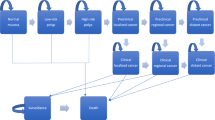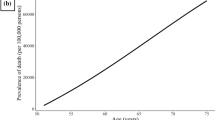Abstract
Background
Biennial faecal occult blood testing (FOBT) for individuals aged 60–69 years is the primary screening tool for colorectal cancer (CRC) in the UK NHS, despite a large number of patients undergoing an unnecessary optical colonoscopy (OC) and evidence from modelling studies to suggest that more cost-effective technologies exist. CT colonography (CTC) is an emerging CRC screening technology with the potential to prevent CRC by detecting pre-cancerous polyps and to detect cancer at an earlier stage.
Objective
To assess the impact of introducing CTC into the UK NHS screening programme for CRC on key health outcomes as well as the NHS budget and healthcare resource capacity.
Methods
A discrete Markov model was used to reflect the natural history of CRC and the impact of three screening scenarios (biennial FOBT with and without CTC triage of patients referred to OC, and CTC every 5 years) on a range of health outcomes, including the incidence and prevalence of CRC, in a hypothetical cohort of individuals. The yearly costs, health outcomes and healthcare resource capacity requirements were estimated over a 10-year period (2009–18).
Results
Using CTC to follow up FOBT-positive patients (scenario 2) was less costly than directing all FOBT-positive patients to OC (scenario 1); saving d776 283 over 10 years for 100 000 individuals invited for screening (year 2007 values), primarily by avoiding approximately 1700 OCs, but was estimated to require 2200 additional CT scans. Implementing a programme of 5-yearly CTC as a primary screen is expected to be more expensive than FOBT screening over the short term (driven by high screening and diagnosis costs), despite substantial savings in treatment costs for CRC over the 10-year time horizon of the model and improved health outcomes.
Conclusions
Adding CTC into the existing NHS Bowel Cancer Screening Programme as part of a preventive screening strategy could be less costly to the NHS over the longer term when used to triage FOBT-positive patients to appropriate follow-up. Increased demand for radiology services may be compensated for by reduced demand in endoscopy units.







Similar content being viewed by others
References
Office for National Statistics. Mortality statistics: cause. Review of the Registrar General on deaths by cause, sex and age, in England and Wales, 2005. Newport: Office for National Statistics, 2006 (Series DH2, No. 32) [online]. Available from URL: http://www.statistics.gov.uk/downloads/theme_health/Dh2_32/DH2_No32_2005.pdf [Accessed 2010 Dec 4]
Office for National Statistics. Cancer statistics registrations: registrations of cancer diagnosed in 2005, England, Newport: Office for National Statistics, 2008 (Series MB1, No. 36) [online]. Available from URL: http://www.statistics.gov.uk/downloads/theme_health/MB1_36/MB1_No36_2005.pdf [Accessed 2010 Dec 4]
Jackman RJ, Mayo CW. The adenoma-carcinoma sequence in cancer of the colon. Surg Gynecol Obstet 1951; 93(3): 327–30
Muto T, Bussey HJ, Morson BC. The evolution of cancer of the colon and rectum. Cancer 1975; 36(6): 2251–70
Winawer SJ, Zauber AG, Ho MN, et al. Prevention of colorectal cancer by colonoscopic polypectomy: the National Polyp Study Workgroup. N Engl J Med 1993; 329(27): 1977–81
National Institute for Health and Clinical Excellence. Improving outcomes in colorectal cancers: manual update. London: NICE, 2004 [online]. Available from URL: http://www.nice.org.uk/nicemedia/pdf/CSGCCfullguidance.pdf [Accessed 2010 Dec 4]
Levin B, Lieberman DA, McFarland B, et al. Screening and surveillance for the early detection of colorectal cancer and adenomatous polyps, 2008: a joint guideline from the American Cancer Society, the US Multi-Society Task Force on Colorectal Cancer, and the American College of Radiology. CA Cancer J Clin 2008; 58(3): 130–60
Tappenden P, Chilcott J, Eggington S, et al. Option appraisal of population-based colorectal cancer screening programmes in England. Gut 2007; 56(5): 677–84
Hardcastle JD, Chamberlain JO, Robinson MH, et al. Randomised controlled trial of faecal-occult-blood screening for colorectal cancer. Lancet 1996; 348(9040): 1472–7
Kronborg O, Fenger C, Olsen J, et al. Randomised study of screening for colorectal cancer with faecal-occult-blood test. Lancet 1996; 348(9040): 1467–71
Towler B, Irwig L, Glasziou P, et al. A systematic review of the effects of screening for colorectal cancer using the faecal occult blood test, hemoccult. BMJ 1998; 317(7158): 559–65
Soares-Weiser K, Bravo VY, Beynon S, et al. A systematic review and economic model of the clinical effectiveness and cost-effectiveness of interventions for preventing relapse in people with bipolar disorder. Health Technol Assess 2007; 11(39): iii–206
McFarland EG, Levin B, Lieberman DA, et al. Revised colorectal screening guidelines: joint effort of the American Cancer Society, US Multi-society Task Force on Colorectal Cancer, and American College of Radiology. Radiology 2008; 248(3): 717–20
Segnan N, Senore C, Andreoni B, et al. Comparing attendance and detection rate of colonoscopy with sigmoidoscopy and FIT for colorectal cancer screening. Gastroenterology 2007; 132(7): 2304–12
Nnoaham KE, Lines C. Modelling future capacity needs and spending on colonoscopy in the English bowel cancer screening programme. Gut 2008; 57(9): 1238–45
Tappenden P, Eggington S, Nixon R, et al. Colorectal cancer screening options appraisal: cost-effectiveness, cost-utility and resource impact of alternative screening options for colorectal cancer. Report to the English Bowel Cancer Screening Working Group. Sheffield: University of Sheffield, School of Health and Related Research (ScHARR), 2004 Sep [online]. Available from URL: http://www.cancerscreening.nhs.uk/bowel/scharr.pdf [Accessed 2010 Dec 4]
Johnson CD, Chen MH, Toledano AY, et al. Accuracy of CT colonography for detection of large adenomas and cancers. N Engl J Med 2008; 359(12): 1207–17
Burling D, Halligan S, Slater A, et al. Potentially serious adverse events at CT colonography in symptomatic patients: national survey of the United Kingdom. Radiology 2006; 239(2): 464–71
Pickhardt PJ. Incidence of colonic perforation at CT colonography: review of existing data and implications for screening of asymptomatic adults. Radiology 2006; 239(2): 313–6
Pickhardt PJ, Choi JR, Hwang I, et al. Computed tomographic virtual colonoscopy to screen for colorectal neoplasia in asymptomatic adults. N Engl J Med 2003; 349(23): 2191–200
Marshall DA, Johnson FR, Kulin NA, et al. How do physician assessments of patient preferences for colorectal cancer screening tests differ from actual preferences? A comparison in Canada and the United States using a stated-choice survey. Health Econ 2009 Dec; 18(12): 1420–39
Lee D, Muston D, Sweet A, et al. Cost effectiveness of CT colonography for UK NHS colorectal cancer screening of asymptomatic adults aged 60–69 years. Appl Health Econ Health Policy 2010; 8(3): 141–54
National Institute for Health and Clinical Excellence. Developing costing tools: methods guide. London: NICE, 2008
NHS Cancer Screening Programmes. NHS bowel cancer screening programme [online]. Available from URL: http://www.cancerscreening.nhs.uk/bowel/index.html [Accessed 2010 Dec 4]
Weller D, Moss S, Butler P, et al. English pilot of bowel cancer screening: an evaluation of the second round. Final report to the Department of Health. Edinburgh: University of Edinburgh, 2006 Feb [online]. Available from URL: http://www.cancerscreening.nhs.uk/bowel/pilot-2nd-round-evaluation.pdf [Accessed 2010 Dec 4]
Atkin WS. Single flexible sigmoidoscopy screening to prevent colorectal cancer: baseline findings of a UK multicentre randomised trial. Lancet 2002; 359(9314): 1291–300
Sosna J, Blachar A, Amitai M, et al. Colonic perforation at CT colonography: assessment of risk in a multicenter large cohort. Radiology 2006; 239(2): 457–463
Brown S, Redgwell G, editors. Key population and vital statistics (series VS No. 33, PPI No. 29). Newport: Office for National Statistics, 2006 [online]. Available from URL: http://www.statistics.gov.uk/downloads/theme_population/KPVS33_2006/FINAL_KPVS2006-web.pdf [Accessed 2010 Dec 4]
Curtis L. Unit costs of health and social care 2007. Kent: Personal Social Services Research Unit, University of Kent, 2007 [online]. Available from URL: http://www.pssru.ac.uk/pdf/uc/uc2007/uc2007.pdf [Accessed 2010 Dec 4]
UK Department of Health. NHS Payment by Results (PbR) in 2007–08 [online]. Available from URL: http://www.dh.gov.uk/en/Publicationsandstatistics/Publications/PublicationsPolicyAndGuidance/DH_062914 [Accessed 2008 Feb 16]
UK Department of Health. NHS reference costs 2006–2007. London: Department of Health, 2008 [online] Available from URL: http://www.dh.gov.uk/en/Publicationsandstatistics/Publications/PublicationsPolicyAndGuidance/DH_082571 [Accessed 2010 Dec 4]
Mauskopf J, Sullivan S, Annemans L, et al. Principles of good practice for budget impact analysis: report of the ISPOR Task Force on Good Research Practices. Value Health 2007; 10: 336–47
Liedenbaum MH, van Rijn AF, de Vries AH, et al. Using CT colonography as a triage technique after a positive faecal occult blood test in colorectal cancer screening. Gut 2009; 58(9): 1242–9
Taylor SA, Halligan S, Saunders BP, et al. Acceptance by patients of multidetector CT colonography compared with barium enema examinations, flexible sigmoidoscopy, and colonoscopy. AJR Am J Roentgenol 2003; 181(4): 913–21
Iannaccone R, Laghi A, Catalano C, et al. Computed tomographic colonography without cathartic preparation for the detection of colorectal polyps. Gastroenterology 2004; 127(5): 1300–11
UK Department of Health. The NHS cancer plan: a plan for investment, a plan for reform (product no. 22293). London: Department of Health, 2000 Sep 27 [online]. Available from URL: http://www.dh.gov.uk/en/Publicationsandstatistics/Publications/PublicationsPolicyAndGuidance/DH_4009609 [Accessed 2010 Dec 4]
Xiong T, Richardson M, Woodroffe R, et al. Incidental lesions found on CT colonography: their nature and frequency. Br J Radiol 2005; 78(925): 22–9
Brenner DJ, Georgsson MA. Mass screening with CT colonography: should the radiation exposure be of concern? Gastroenterology 2005; 129(1): 328–37
Acknowledgements
The analysis and manuscript production was sponsored by GE Healthcare, who manufacture CT colonography equipment and software. The authors acknowledge the contributions of Dominic Muston (Heron Evidence Development) for health economics guidance and Chris Cunningham (Clinical Lead for Colorectal Surgery, Oxford Radcliffe Hospitals NHS Trust) and Andrew Slater (Consultant gastrointestinal radiologist, Oxford Radcliffe Hospitals NHS Trust) for clinical expertise.
David Lee and Alison Sweet are employed by GE Healthcare. Kerry Gairy, Denver Phiri, Timothy Reason and Kevin Lock are employed by Heron Evidence Development, who received funding from GE Healthcare for this study.
Author information
Authors and Affiliations
Corresponding author
Electronic supplementary material
Rights and permissions
About this article
Cite this article
Sweet, A., Lee, D., Gairy, K. et al. The impact of CT colonography for colorectal cancer screening on the UK NHS. Appl Health Econ Health Policy 9, 51–64 (2011). https://doi.org/10.2165/11588110-000000000-00000
Published:
Issue Date:
DOI: https://doi.org/10.2165/11588110-000000000-00000




